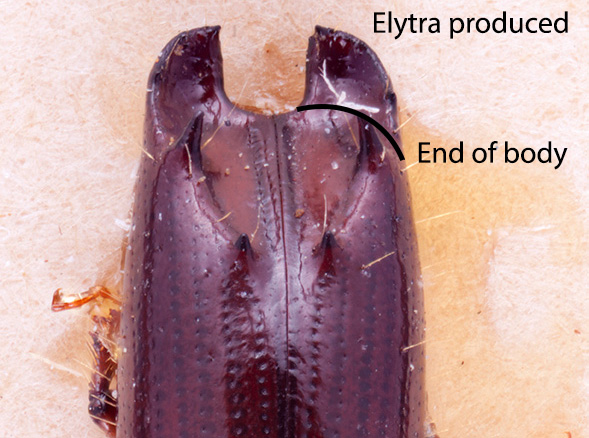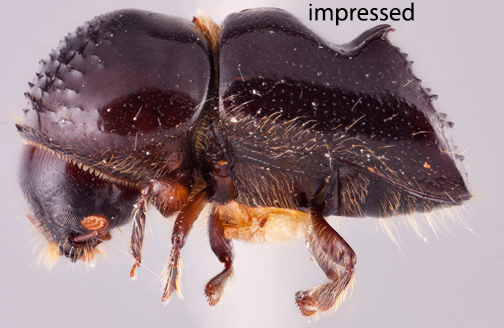About this tool
What are ambrosia beetles?
The term ‘ambrosia beetles’ refers to groups of scolytines that share the habit of culturing symbiotic fungi. However, ambrosia beetles are not a taxonomic group. This ambrosia habit has evolved at least 16 times in different scolytines, and each of the independent lineages has its own unique biological and morphological characteristics (Johnson et al. 2018Johnson et al. 2018:
Johnson AJ, McKenna DD, Jordal BH, Cognato AI, Smith SM, Lemmon AR, Moriarty Lemmon EL, Hulcr J. 2018. Phylogenomics clarifies repeated evolutionary origins of inbreeding and fungus farming in bark beetles (Curculionidae, Scolytinae). Molecular Phylogenetics and Evolution 127: 229-238. https://doi.org/10.1016/j.ympev.2018.05.028). All ambrosia beetles tunnel directly into the sapwood of their tree host, cultivate a fungus garden, and transport the fungi in specialized structures termed mycangiamycangia:
structures used to carry fungal symbionts; highly morphologically variable
 . But because each of the groups have evolved the habit separately, their fungi are different, details of their ecology and genetic systems are different, even the mycangiamycangia:
. But because each of the groups have evolved the habit separately, their fungi are different, details of their ecology and genetic systems are different, even the mycangiamycangia:
structures used to carry fungal symbionts; highly morphologically variable
 are on different parts of their bodies (Mayers et al. 2022Mayers et al. 2022:
are on different parts of their bodies (Mayers et al. 2022Mayers et al. 2022:
Mayers CG, Harrington TC, Biedermann PHW. 2022. Mycangia define the diverse ambrosia beetle - fungus symbioses (pp. 105-142). In: Schultz TR, Gawne R, Peregrine PN, eds. The Convergent Evolution of Agriculture in Humans and Insects, The MIT Press, Cambridge, MA.).
Xyleborini ambrosia beetles
The scolytine tribe Xyleborini represents the largest radiation of ambrosia beetles. This tribe of over 1300 species evolved very recently, only within 20 mya (Jordal and Cognato 2012Jordal and Cognato 2012:
Jordal BH, Cognato AI. 2012. Molecular phylogeny of bark and ambrosia beetles reveals multiple origins of fungus farming during periods of global warming. BMC Evolutionary Biology 12: 133. https://doi.org/10.1186/1471-2148-12-133). This rapid radiation means that some genera are not readily diagnosed, and many species within the genera are typically very morphologically similar. Many closely related species of Xyleborini only differ by to subtle morphological differences, or the variable morphological features do not correspond with species boundaries.
Like bees, ants, and wasps, xyleborines possess a haplodiploid reproductive system in which diploid females produce diploid daughters and haploid sons. In Xyleborini, the haplo-diploidy is also combined with extreme inbreeding in which most males mate only with their sisters. Xyleborine broods exhibit strong sex ratio bias with many more females producedproduced:
referring to a part of the exoskeleton that is extended, lengthened or elevated
 than males. Males are dwarfed, flightless, and rarely leave their natal gallery. Males typically look quite different from females and can be distinguished by their smaller size and impressedimpressed:
than males. Males are dwarfed, flightless, and rarely leave their natal gallery. Males typically look quite different from females and can be distinguished by their smaller size and impressedimpressed:
a depression in a surface
 area on the anterioranterior:
area on the anterioranterior:
the front or forward; opposite of posterior half of the pronotumpronotum:
half of the pronotumpronotum:
the dorsal surface of the thorax
. This inbreeding mating system is what has allowed xyleborines to rapidly diversify and makes them ideally suited to colonize new geographic areas because only a single female is needed to establish a population (Smith and Hulcr 2015Smith and Hulcr 2015:
Smith SM, Hulcr J. 2015. Scolytus and other economically important bark and ambrosia beetles. In: Vega FE, Hofstetter RW (Eds) Bark Beetles: Biology and ecology of native and invasive species. Elsevier, San Diego, CA, 495minus;531.).
Nearly all xyleborines possess mycangiamycangia:
structures used to carry fungal symbionts; highly morphologically variable
 , cuticular pouches specialized for storing spores of their symbiotic ambrosia fungus. There are three main types of mycangiamycangia:
, cuticular pouches specialized for storing spores of their symbiotic ambrosia fungus. There are three main types of mycangiamycangia:
structures used to carry fungal symbionts; highly morphologically variable
 : oral, mesonotal, and elytralelytral:
: oral, mesonotal, and elytralelytral:
pertaining to the elytra
. Some mesonotal and elytralelytral:
pertaining to the elytra
mycangia are externally marked by dense patches of setaeseta:
small hair-like or scale-like structure
at the pronotalpronotal:
pertaining to the pronotum
basebase:
point or edge closest to the body; opposite of apex and scutellumscutellum:
and scutellumscutellum:
a shield-like sclerotized plate located at the midpoint of the elytral base
respectively. Several xyleborine genera, including Ambrosiophilus and Diuncus, contain species that steal ambrosia fungus from other xyleborines by excavating their galleries close to the host beetle and parasitizing the fungus growing around it for their own galleries. This habit termed ‘mycocleptism’ has also independently evolved several times in scolytines (Hulcr and Cognato 2010bHulcr and Cognato 2010b:
Hulcr J, Cognato AI. 2010b. Repeated evolution of theft in fungus farming ambrosia beetles. Evolution 64: 3205-3212. https://doi.org/10.1111/j.1558-5646.2010.01055.x).
In general, ambrosia fungus farming freed xyleborines from strict specificity to particular host trees, as the beetles consume fungus rather than host tissue and are thus not limited by the host’s secondary chemistry. They tend to be known from a wide diversity of hosts. If a species is host specific, it is at the family level rather than the generic or specific level. Due to their association with fungi, it is unsurprising that xyleborines can also serve as tree fungal disease vectors, leading to death of the infected host (Smith and Hulcr 2015Smith and Hulcr 2015:
Smith SM, Hulcr J. 2015. Scolytus and other economically important bark and ambrosia beetles. In: Vega FE, Hofstetter RW (Eds) Bark Beetles: Biology and ecology of native and invasive species. Elsevier, San Diego, CA, 495minus;531.).

